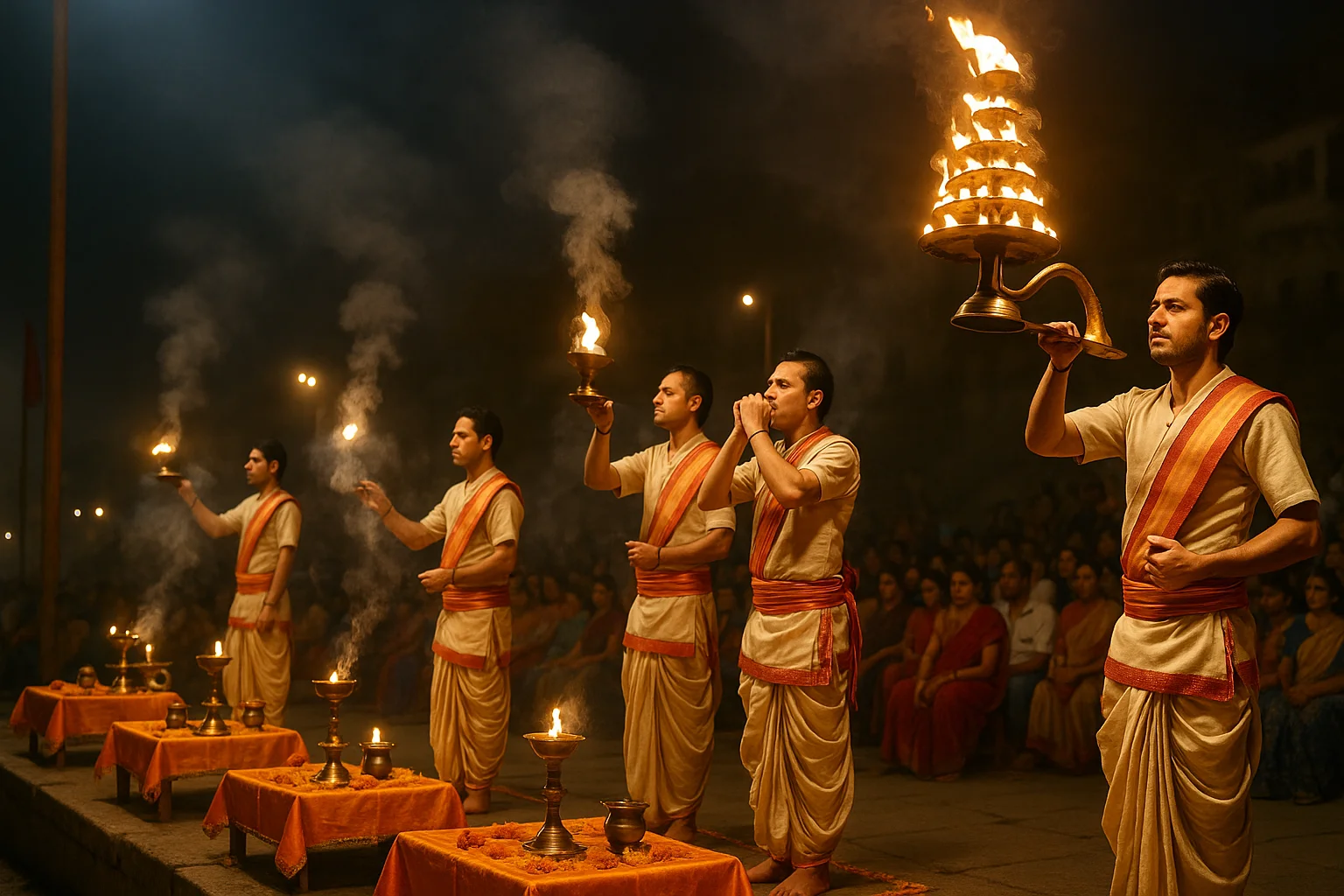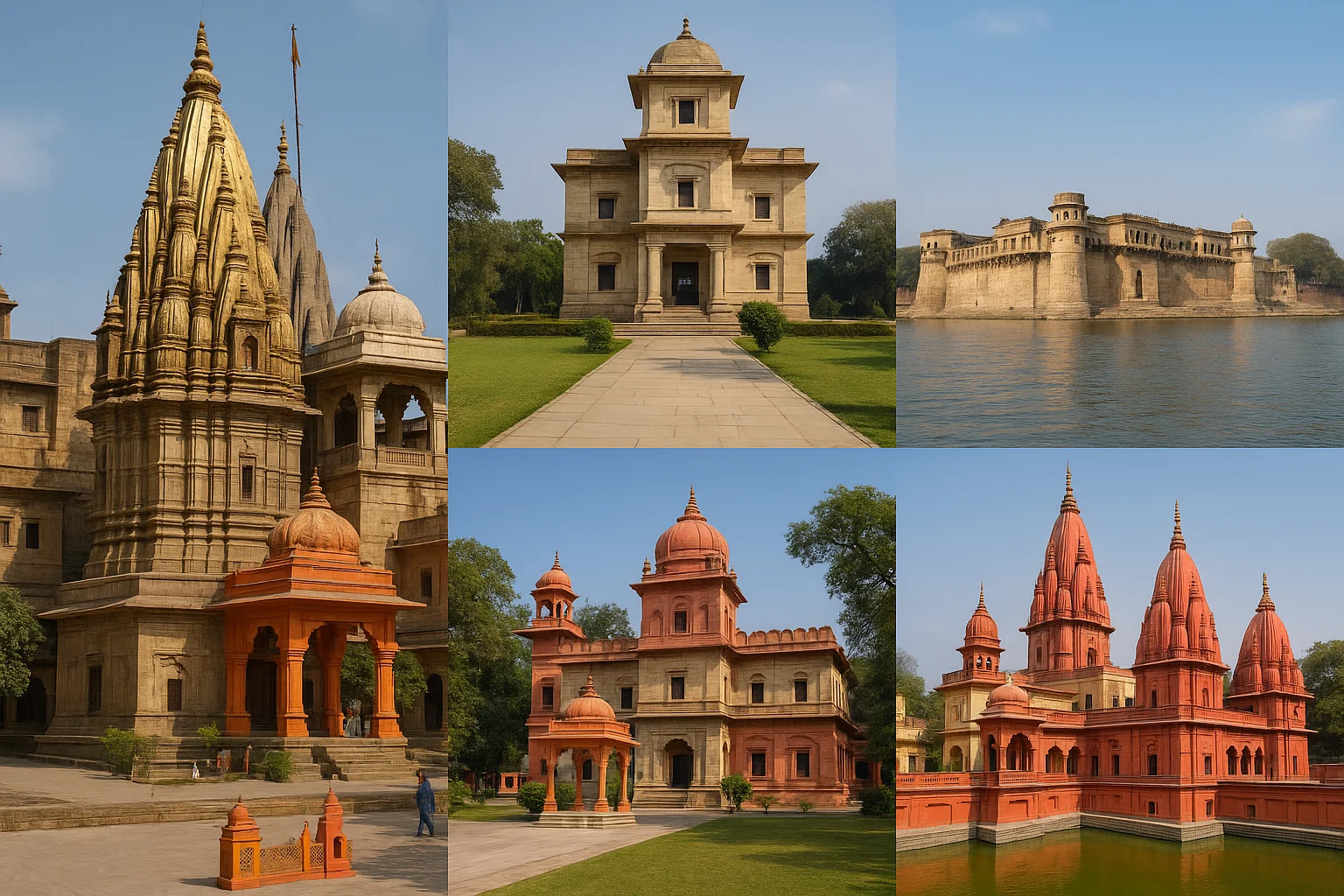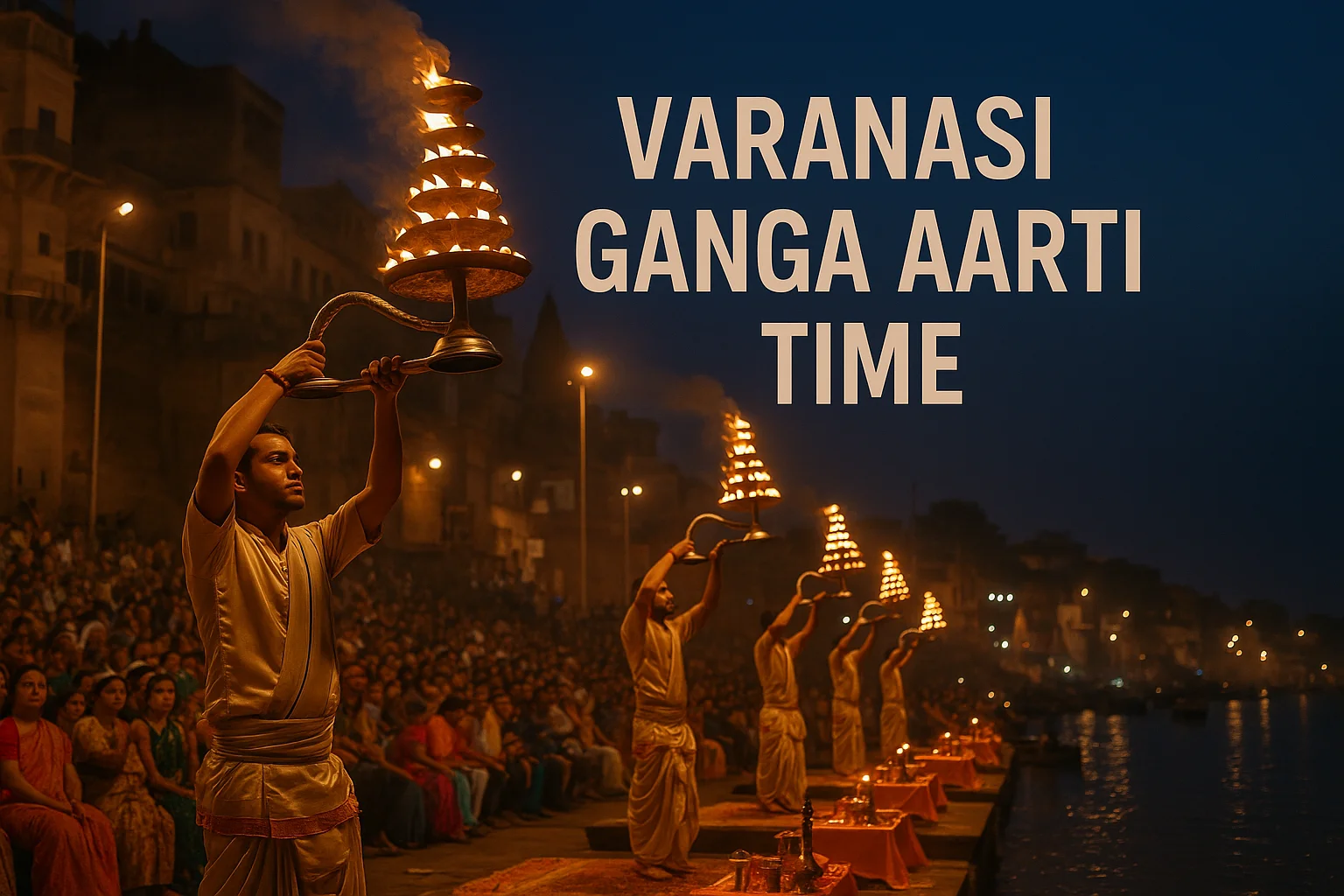Varanasi Ganga Aarti Time: Varanasi, also known as Kashi, is the spiritual capital of India. It is one of the Sapta Puri, which means seven divine cities. These cities are Ayodhya, Mathura, Kanchipuram, Ujjain, and Dwarka. It is said that Lord Shiva himself created this city.
Today, millions of devotees and travellers visit this city for many reasons. Witnessing the Ganga Aarti is one of them. The Ganga Aarti takes place daily at the ghats of the holy river Ganga.
As this light, sound, and devotion ritual is filled with divine energy, the atmosphere becomes completely electrifying. In Varanasi, there are 84 Ghats.
The famous and grand Ganga Aarti is only organized at the Dashashwamedh Ghat and Assi Ghat. If you are also going to visit here for the first time, then once know about the timing of the Aarti held at Assi Ghat.
Let us tell you, this time keeps changing in both summer and winter seasons, and now winter is almost over. After this, tourists going in summer should definitely know the time of Aarti.
Varanasi Ganga Aarti Time
The Ganga Aarti is a Hindu ceremony performed every day by Hindus to honour Maa Ganga. Ganga Aarti is performed daily at Dashashwamedh Ghat and Assi Ghat.
There are priests dressed in saffron color Dhotis, chanting in an organized manner, offering the lamps (diyas), and blowing the Shankh.
The environment is aromatic from the incense that is being burned; ringing bells, singing hymns, and the atmosphere is divine. Earlier, the Ganga aarti in Varanasi was conducted only in the evening.
It always took place just after sunset. In the extreme summer months, it would start at around 7 pm, and in the winter months, it would mostly happen at about 6 pm.
While the evening aarti’s main priority is almost only on Dashashwamedh Ghat, the morning aarti is more focused on Assi Ghat. The Ganga Aarti Varanasi Time can also differ based on the season.
Here is the timetable for Ganga Aarti in Varanasi:
| Season | Morning Aarti Timing | Evening Aarti Timing |
| Summer | 5:00 AM – 5:30 AM | 6:45 PM – 7:30 PM |
| Monsoon | 5:00 AM – 5:30 AM | 6:30 PM – 7:15 PM |
| Winter | 5:15 AM – 5:45 AM | 5:45 PM – 6:30 PM |
Overview of Ganga Aarti at Varanasi
Varanasi is also known as Banaras and Kashi. The city is the spiritual capital of India. The Varanasi Ganga Aarti is world famous and attracts millions of devotees and tourists every year.
Not only do the Indians visit Kashi, but foreigners also show interest in visiting Varanasi. The grand Ganga Aarti is organized mainly at Dashashwamedh Ghat and Assi Ghat.
Aarti at Dashashwamedh Ghat started in 1991. Assi Ghat is also the famous ghat where Ganga Aarti is held every day. Here, the Assi River meets the Ganga, and is also known as the Assi Sambed Tirths.
Ganga Aarti is not just a spiritual tradition, but a sacred ceremony that invites people from all around the world. If you are visiting Varanasi for the first time, then knowing the Ganga Aarti Varanasi time, where to go, and what it is like will allow you to admire the Ganga Aarti experience fully.
Also Read: 16 संस्कारों के नाम और उनका धार्मिक अर्थ
From the Morning Ganga Aarti timings at Assi Ghat to the grand evening Ganga Aarti when it is near Sunset at Dashashwamedh Ghat. This blog will cover it all.
How is Ganga Aarti in Varanasi Performed?
Ganga Aarti in Varanasi is a beautiful spectacle of faith and delight. The sacred River Ganga is honoured with devotion twice every day. The Aarti begins with the priests wearing the traditional attire of Dhoti and Kurta tied with a Gamchha.
The Pandits set up five platforms, which are slightly above the ghats, and collect the ritual items like brass lamps, idols of Ganga Devi, flowers, and incense sticks before the Aarti.

The Ganga Aarti is performed by Pandits familiar with the Vedas and Upanishads, led by the head priest of the Gangotri Samiti.
The ceremony begins with the lighting of traditional brass lamps, which are accompanied by rhythmic chanting of holy mantras.
Some priests purify the atmosphere by blowing the Shankh, while others perform the aarti of Maa Ganga by lighting incense.
After the initial mantras, the priest performs the aarti by lighting a lamp with camphor. This mesmerizing aarti fills the atmosphere with purity and peace. The Aarti is performed for 45 minutes.
Religious Beliefs Behind the Varanasi Ganga Aarti
Dashaswamedh Ghat
Dashashwamedh Ghat is one of the oldest and most significant ghats of Varanasi. In mythology, Lord Brahma conducted ten Ashvamedha Yajnas here, which gave this ghat spiritual significance. For these reasons, this ghat has been practising rituals and religious activities for a long time.
In 1991, Ganga Aarti was started at Dashashwamedh Ghat under the leadership of Pandit Satyendra Mishra Mundan Maharaj, which later became a daily routine here. This Aarti was inspired by the Aarti held in Haridwar, but a deep faith in it developed among the people.
Assi Ghat
At the same time, the matter comes to Assi Ghat, which is very ancient. This is the place where the Assi River meets the Ganges.
In the Puranas, Assi Ghat is mentioned as ‘Assi Sambed Tirtha’, and it is believed that taking a holy dip here gives as much virtue as taking a dip in all other pilgrimage places. The morning Aarti at Assi Ghat, known as ‘Subah-e-Banaras’, is famous for its peace and spiritual energy.
Other Reasons Behind Ganga Aarti
- Both the Dashaswamedh and Assi Ghats are relatively wide and open, providing enough space for many people to witness and attend the aarti.
- Compared to other ghats, it is better for tourists.
- While it is right that Ganga Aarti is arranged on a smaller scale at other ghats of Varanasi, they are not as extravagant as the Dashashwamedh and Assi Ghats. However, they too have their own prominence among the devotees.
Best Time to Experience Ganga Aarti in Varanasi
In this section, we will tell you the best time to visit Varanasi for Ganga Aarti. As you all know, Ganga Aarti is the key focus of Varanasi, and it is done every day.
Aarti is done twice a day, in the morning and evening. The best time to attend is during the months of October to March. The time between October to March is the best to indulge in the spirituality of the Ganga Aarti.
This period offers the most pleasant weather, making it comfortable to sit along the ghats and thoroughly soak in the spiritual ambience. The weather is also perfect. You will not feel hot during this time.
Visiting Varanasi Ganga Aarti during the time of Dev Deepawali, Kartik Purnima, and Ganga Dussehra is also a great experience. The energy is not only more spiritual, but you will feel more connected with God.
Also Read: Mata Vaishno Devi Ropeway: Timings, Ticket Prices & Online Booking
Having details of the Varanasi Ganga Aarti timing is crucial on these festive days since the flock of people and positive energy come early.
Either you go in the middle of a less crowded weekday, or during a peak festival. Scheduling based on the Varanasi Ganga Aarti timing will have you at your strongest, witnessing this sacred ritual.
Etiquettes to follow for Varanasi Ganga Aarti
- Maintain Silence: When watching the sacred Ganga Aarti in Varanasi, be respectfully quiet. Respect the spiritual presence and should not disturb the other devotees.
- No Flash Photography: Please turn off your flash so that you won’t interfere with other people’s comfort and the priest’s comfort.
- Respect Seating Arrangement: While members of the group sit where they need to, please do not use any reserved seat or platform without asking permission first.
- Don’t Block Other People: When you take photos or move around, maintain awareness of other people’s views.
- Don’t Litter: Please don’t make a mess. Dispose of anything properly, even if something is singularly small.
- Dress Modestly: When visiting any religious or sacred place like temples, always remember appropriate clothing to honour the cultural meaning of the event. Try to wear a Saree or a suit during the Ganga Aarti.
- Avoid Eating or Drinking: Please do not eat or drink in the ceremony. There are loads of nice street food and cafes at night; why eat and drink in the ceremony?
- Stay till the End: You are only able to sit if you want. There is no restriction or law to make you sit, but it is rude to walk away from the ritual in the middle of it.
- Respect the Priests: The priests will smoothly and quietly perform the rituals, not as conditioned. Try not to interfere in the ceremony and disturb them.
- No Photography after the ceremony: Don’t treat the priests as props after the ceremony. Not everyone wants to be a part of your selfies and pictures. They work hard to maintain pious devotion and work; respect that.
Dos and Don’ts for Varanasi Ganga Aarti
Dos:
- Try to arrive early to avoid a heavy crowd. Arrive 45 minutes before the Ganga Aarti at the Ghat.
- Always bring your own water & cloth.
- Be considerate of the silence and sacred chants and respect the ceremony.
- Always try to check with your hotel and homestay about the current Varanasi Ganga Aarti Timings.
Don’ts
- Avoid throwing the trash at the ghats and ensure the cleanliness there.
- Do not argue with the locals or boatmen.
- Avoid taking photos and videos that are prohibited and intrusive to worshippers.
- There are several scammers at the religious places who try to sell you fake VIP passes. Avoid them.
Knowing how to prepare for Ganga Aarti goes a long way toward avoiding all the chaos. Dress appropriately, wear sensible footwear, and keep your valuables safe.
More Places to Visit in Varanasi
Apart from the Ghats like Assi Ghat and Dashaswamedh Ghat, there are several places that you should visit in Varanasi. These top places to visit in Kashi are:

1. Kashi Vishwanath Temple
Many people see it as the most prominent temple in Varanasi, and some consider it the most important temple in the entire country. The story of this temple is more than three thousand five hundred years old.
Kashi Vishwanath Temple is one of the 12 Jyotirlingas, which millions of people visit every year. Many devotees believe that a glimpse of Shivlinga purifies your soul and leads life to the path of knowledge. We believe that you should start your tour of Varanasi from this place.
2. Bharat Mata Mandir, Varanasi
Among all the Bharat Mata Mandirs present across India, this is one of the oldest temples in the country. It is said to have been inaugurated by Mahatma Gandhi in 1936.
This is one of the best places to visit in Varanasi that you can plan to visit with your family. It is located in the Mahatma Gandhi Kashi Vidyapeeth campus.
3. Ramnagar Fort
The Ramnagar Fort is situated across the Ganges River from the Tulsi Ghat. The temple was built in sandstone in 1750 AD by the king of Banaras, Balwant Singh.
In 1971, the government ended the title of the official king, and Maharaja Pelu Biru Singh is still referred to as the Maharaja of Varanasi. The temple also houses the Ved Vyas Temple, the king’s residence, and a museum of local history.
4. Sankat Mochan Hanuman Temple
Sankat Mochan Hanuman Temple is located on the banks of the Assi River and was built by freedom fighter Pandit Madan Mohan Malviya in the 1900s.
It is dedicated to Lord Rama and Hanuman. Varanasi is always associated with the Sankat Mochan Temple and is an essential part of this holy city.
5. Durga Temple, Varanasi
It is believed that the idol of the goddess situated in the Durga temple of Varanasi was not made by any man. This idol appeared from the air itself. It is located in Durgakund.
6. New Vishwanath Temple
Located inside Banaras Hindu University, this temple is visited by a lot of tourists daily. The Birla family, which has been a very successful group of entrepreneurs in India, started its construction.
One great thing about the temple is that it is not just one building, but actually seven different temples that together form a large religious complex.
Conclusion
The spiritual capital of India is famous for the Kashi Vishwanath Temple in Varanasi and the grand Ganga Aarti. Priests perform the Aarti at the Assi Ghat in the morning and at the Dashashwamedh Ghat in the evening.
The Ganga Aarti in Varanasi is more than a tourist activity – it’s a memory that lasts a lifetime. No matter if you arrive with spiritual intent or as a fun curiosity, there is something that can change you when you witness the sacred rituals that unfold along the banks of the River Ganges.
As you witness the sacred chants, time seems to stop. With the swirling plumes of incense and the glowing flames dancing with the river’s flow, you will feel peace. I hope this article answers all your queries about the Varanasi Ganga Aarti Time and locations.

